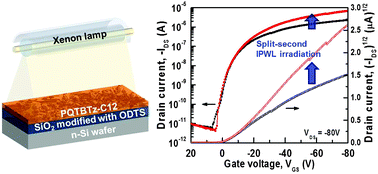Intense pulsed light induced crystallization of a liquid-crystalline polymer semiconductor for efficient production of flexible thin-film transistors†
Abstract
Here we demonstrated the split-second crystallization of a liquid-crystalline conjugated polymer semiconductor induced by irradiation with intense pulsed white light (IPWL) for the efficient improvement of electrical properties of flexible thin film transistors. A few seconds of IPWL irradiation of poly(didodecylquaterthiophene-alt-didodecylbithiazole) (PQTBTz-C12) thin films generated heat energy through the photo-thermal effect, leading to the crystallization of PQTBTz-C12 and formation of nodule-like nanostructures. The IPWL-induced crystallization of PQTBTz-C12 resulted in a threefold improvement in the field-effect mobility of thin film transistors compared to as-prepared devices. The conformational change of the PQTBTz-C12 chains was found to be strongly related to the irradiation fluence. As a proof-of-concept, the IPWL treatment was successfully applied to the PQTBTz-C12 layer in flexible transistors based on plastic substrates. The performance of these flexible devices was significantly improved after only 0.6 s of IPWL treatment, without deformation of the plastic substrate.


 Please wait while we load your content...
Please wait while we load your content...